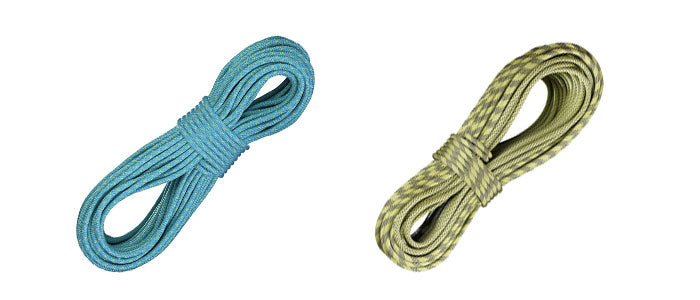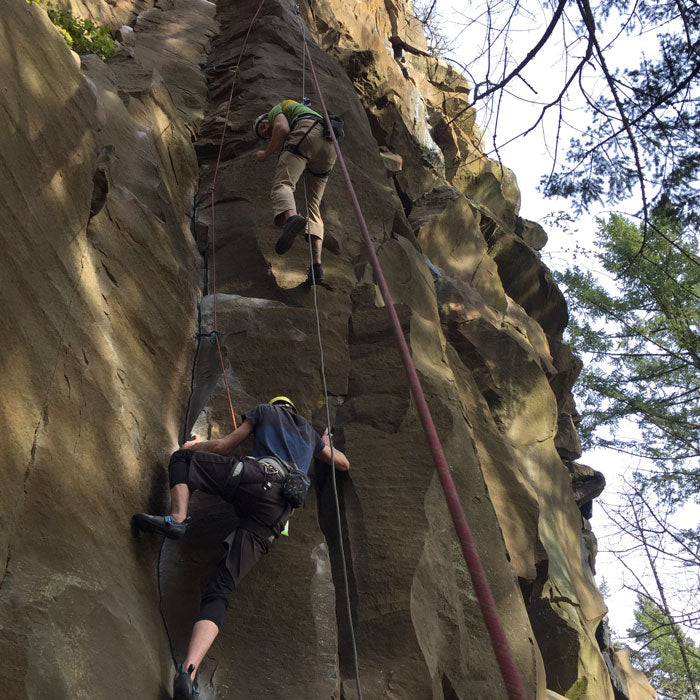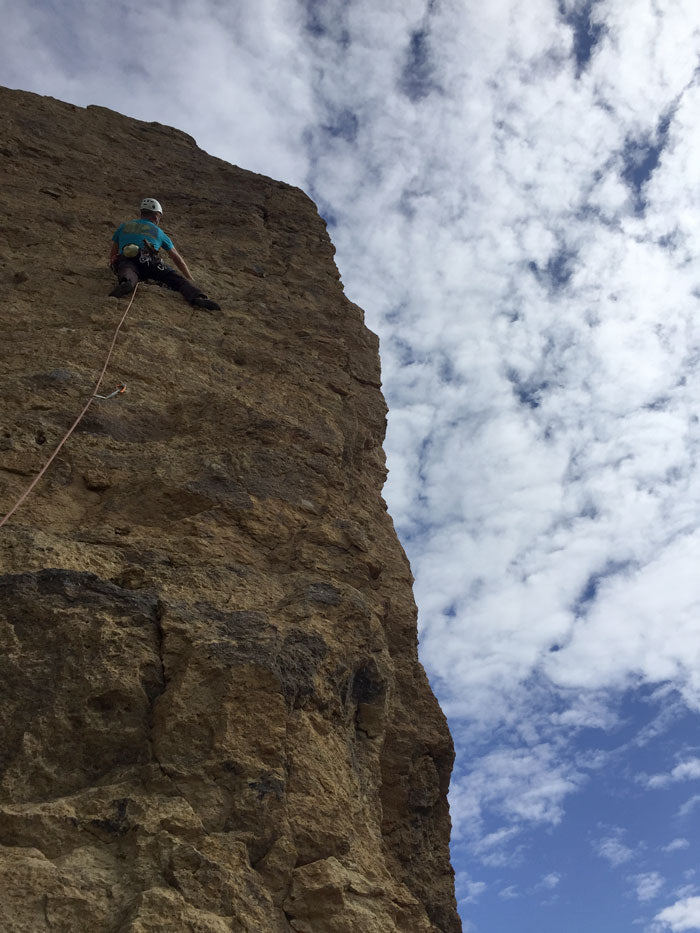
Climbing Ropes: What Is A Climbing Rope?
The modern climbing rope is likely the most revolutionary piece of outdoor gear available. I cannot think of another tool that is so simple but makes so much adventure possible. If it wasn’t for dynamic nylon ropes and their near-magical ability to reduce impact forces in a fall, climbing would not exist like it does today.
Ropes, of course, do not work on their own. They are just a part of the rope system, which consists of the climber (who leads the way up the rock) the belayer (who holds the other end of the rope and controlling how much rope is between the two partners. “Belay” also refers to the act of managing the rope or the pace where the belayer works), protection (anything that connects the rope to the rock) and an anchor (the ground in case of single-pitch climbing, and a cluster of protection for belays on multi-pitch routes. All these components work together to protect the climber during a fall.
Climbing ropes were originally made of hemp and were static-they did not stretch when a climber fell, and they did not the absorb the force of the fall. This meant that a climber would fall until the end of the rope was reached then stop with a sudden jerk. The other end of the rope would also jerk suddenly, often ripping out protection or pulling belayers off their stance-with sometimes fatal consequences.
 Since the introduction of Kermantle ropes by the German company Edlrid in 1953, ropes have stretched during falls to absorb some of that force. You can think of a climber’s falling body like a car driving towards a brick wall. The brick wall represents the old, static rope system. It will stop the car all at once and the amount of force will be very high, damaging the car and possibly breaking the wall (tearing out the belay). Modern nylon ropes are like the car’s brakes: they absorb all the force needed to stop the car, but they do it over a few seconds so that peak forces never get too high. And just like car brakes, ropes can spring back after being stretched out in a fall so that they can absorb falls repeatedly.
However, ropes that are climbed on too long or aren’t maintained properly can lose their ability to adequately absorb the force of a fall. Grit and grime can work their way into the rope’s core (the part that does the real work) and break it down. As these core fibers are worn, they are no longer as capable of stretching during a fall or recovering to their relaxed position between falls. This means less ability to absorb the force of the fall, and greater force being applied to the climber, belayer, and the protection.
There are also several different kinds of ropes out there, with different applications. I personally own four ropes and can think of three more that I want. In the works are two other posts about which ropes are right for different climbers and what can be done to get a long, enjoyable life out of your rope.
I hope you found this enlightening, and I hope you’ll read my upcoming posts about rope selection and maintenance. If you’re in the Portland area swing by next adventure to check out our wide selection of ropes and other climbing gear, or just to say hi! If you have any questions or feedback for me I’m available at hanrahan.matt@gmail.com.
Read all of Matt's Dirtbag Adventures!
Since the introduction of Kermantle ropes by the German company Edlrid in 1953, ropes have stretched during falls to absorb some of that force. You can think of a climber’s falling body like a car driving towards a brick wall. The brick wall represents the old, static rope system. It will stop the car all at once and the amount of force will be very high, damaging the car and possibly breaking the wall (tearing out the belay). Modern nylon ropes are like the car’s brakes: they absorb all the force needed to stop the car, but they do it over a few seconds so that peak forces never get too high. And just like car brakes, ropes can spring back after being stretched out in a fall so that they can absorb falls repeatedly.
However, ropes that are climbed on too long or aren’t maintained properly can lose their ability to adequately absorb the force of a fall. Grit and grime can work their way into the rope’s core (the part that does the real work) and break it down. As these core fibers are worn, they are no longer as capable of stretching during a fall or recovering to their relaxed position between falls. This means less ability to absorb the force of the fall, and greater force being applied to the climber, belayer, and the protection.
There are also several different kinds of ropes out there, with different applications. I personally own four ropes and can think of three more that I want. In the works are two other posts about which ropes are right for different climbers and what can be done to get a long, enjoyable life out of your rope.
I hope you found this enlightening, and I hope you’ll read my upcoming posts about rope selection and maintenance. If you’re in the Portland area swing by next adventure to check out our wide selection of ropes and other climbing gear, or just to say hi! If you have any questions or feedback for me I’m available at hanrahan.matt@gmail.com.
Read all of Matt's Dirtbag Adventures!
 Some friends from Portland Rock Gym use all sorts of ropes. Daniel (below) top ropes on a single dynamic rope, while Erik (above) ascends a static line to take pictures.
Some friends from Portland Rock Gym use all sorts of ropes. Daniel (below) top ropes on a single dynamic rope, while Erik (above) ascends a static line to take pictures.
 Stuart, a friend I met at Smith Rock a few months ago, leads the final pitch or Voyage of the Cow Dogs. A light, thin, single rope can be ideal for long pitches, the 9.2 Mammut Revelation Dry we used that day worked perfectly.
Stuart, a friend I met at Smith Rock a few months ago, leads the final pitch or Voyage of the Cow Dogs. A light, thin, single rope can be ideal for long pitches, the 9.2 Mammut Revelation Dry we used that day worked perfectly.
 Since the introduction of Kermantle ropes by the German company Edlrid in 1953, ropes have stretched during falls to absorb some of that force. You can think of a climber’s falling body like a car driving towards a brick wall. The brick wall represents the old, static rope system. It will stop the car all at once and the amount of force will be very high, damaging the car and possibly breaking the wall (tearing out the belay). Modern nylon ropes are like the car’s brakes: they absorb all the force needed to stop the car, but they do it over a few seconds so that peak forces never get too high. And just like car brakes, ropes can spring back after being stretched out in a fall so that they can absorb falls repeatedly.
However, ropes that are climbed on too long or aren’t maintained properly can lose their ability to adequately absorb the force of a fall. Grit and grime can work their way into the rope’s core (the part that does the real work) and break it down. As these core fibers are worn, they are no longer as capable of stretching during a fall or recovering to their relaxed position between falls. This means less ability to absorb the force of the fall, and greater force being applied to the climber, belayer, and the protection.
There are also several different kinds of ropes out there, with different applications. I personally own four ropes and can think of three more that I want. In the works are two other posts about which ropes are right for different climbers and what can be done to get a long, enjoyable life out of your rope.
I hope you found this enlightening, and I hope you’ll read my upcoming posts about rope selection and maintenance. If you’re in the Portland area swing by next adventure to check out our wide selection of ropes and other climbing gear, or just to say hi! If you have any questions or feedback for me I’m available at hanrahan.matt@gmail.com.
Read all of Matt's Dirtbag Adventures!
Since the introduction of Kermantle ropes by the German company Edlrid in 1953, ropes have stretched during falls to absorb some of that force. You can think of a climber’s falling body like a car driving towards a brick wall. The brick wall represents the old, static rope system. It will stop the car all at once and the amount of force will be very high, damaging the car and possibly breaking the wall (tearing out the belay). Modern nylon ropes are like the car’s brakes: they absorb all the force needed to stop the car, but they do it over a few seconds so that peak forces never get too high. And just like car brakes, ropes can spring back after being stretched out in a fall so that they can absorb falls repeatedly.
However, ropes that are climbed on too long or aren’t maintained properly can lose their ability to adequately absorb the force of a fall. Grit and grime can work their way into the rope’s core (the part that does the real work) and break it down. As these core fibers are worn, they are no longer as capable of stretching during a fall or recovering to their relaxed position between falls. This means less ability to absorb the force of the fall, and greater force being applied to the climber, belayer, and the protection.
There are also several different kinds of ropes out there, with different applications. I personally own four ropes and can think of three more that I want. In the works are two other posts about which ropes are right for different climbers and what can be done to get a long, enjoyable life out of your rope.
I hope you found this enlightening, and I hope you’ll read my upcoming posts about rope selection and maintenance. If you’re in the Portland area swing by next adventure to check out our wide selection of ropes and other climbing gear, or just to say hi! If you have any questions or feedback for me I’m available at hanrahan.matt@gmail.com.
Read all of Matt's Dirtbag Adventures!
 Some friends from Portland Rock Gym use all sorts of ropes. Daniel (below) top ropes on a single dynamic rope, while Erik (above) ascends a static line to take pictures.
Some friends from Portland Rock Gym use all sorts of ropes. Daniel (below) top ropes on a single dynamic rope, while Erik (above) ascends a static line to take pictures.
 Stuart, a friend I met at Smith Rock a few months ago, leads the final pitch or Voyage of the Cow Dogs. A light, thin, single rope can be ideal for long pitches, the 9.2 Mammut Revelation Dry we used that day worked perfectly.
Stuart, a friend I met at Smith Rock a few months ago, leads the final pitch or Voyage of the Cow Dogs. A light, thin, single rope can be ideal for long pitches, the 9.2 Mammut Revelation Dry we used that day worked perfectly.








